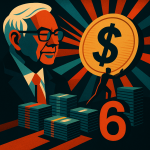Key Points
- OPEC+ plans to boost oil production by 548,000 barrels per day (bpd) for September, aiming to reverse all of last year’s production cuts.
- This increase is largely driven by a looming shortfall of Russian oil due to new U.S. and E.U. sanctions, even as India continues to buy Russian oil.
- Analysts, including Carsten Fritsch from Commerzbank and JPMorgan (Mógen Dàtōng 摩根大通), believe the OPEC+ increase is insufficient to prevent a major price spike, as it covers only about 20% of the potential 2.75 million bpd Russian supply gap.
- Beyond production, investors are watching other factors like U.S. tariffs, which have been a primary driver of bullish oil prices.

OPEC+’s fresh commitment to increase oil production is making headlines, but the real story is much more complex.
On August 3, 2025, a group of eight OPEC+ member countries greenlit a plan to boost daily oil production by 548,000 barrels per day (bpd) for September.
While this sounds like a significant move, it’s unfolding against a backdrop of intense geopolitical pressure and market shifts that could dwarf this increase entirely.
Let’s break down what’s happening and what it means for global markets.
The Production Hike: By The Numbers
OPEC+, the alliance controlling about half of the world’s oil, is reversing its previous strategy of production cuts.
Faced with demands to regain market share, the group has been steadily ramping up output all year.
- April: +138,000 bpd
- May, June, July: +411,000 bpd (each month)
- August: +548,000 bpd
- September (Proposed): +548,000 bpd
If the September increase goes through, it will officially reverse all of last year’s production cuts.
The alliance is set to meet again on September 7, 2025, to finalize this decision and assess a potential larger increase of 1.66 million bpd by the end of December.

Resume Captain
Your AI Career Toolkit:
- AI Resume Optimization
- Custom Cover Letters
- LinkedIn Profile Boost
- Interview Question Prep
- Salary Negotiation Agent

Geopolitical Chess: The Russia Factor in the OPEC+ Decision
A huge driver behind this production hike is the looming shortfall of Russian oil.
The United States and the European Union are tightening the screws on Russia with a new round of sanctions.
These measures include a lower price cap for buyers of Russian crude, putting serious pressure on Russia’s customers.
However, not everyone is falling in line.
India, a massive energy consumer, has made it clear it will continue buying oil from Russia.
Randhir Jaiswal, a spokesperson for India’s Ministry of External Affairs, stated that India’s priority is securing its own energy needs based on market availability.
This isn’t a small deal. According to data from analytics firm Kpler, Russian oil once accounted for nearly 40% of India’s total oil imports, making Moscow its single largest supplier.

- Potential Russian Supply Gap (from US sanctions threats): 2,750,000 bpd
- OPEC+ September Production Increase: 548,000 bpd
- OPEC+ Increase Coverage of Gap: Approximately 20%
The Big Question: Will This Stop a Price Surge?
Here’s the critical takeaway: The planned increase from OPEC+ might not be enough to prevent a major price spike.
Analysts Say: Don’t Bet on It
The numbers just don’t add up.
Carsten Fritsch, an analyst at Commerzbank, put it bluntly: it is impossible for OPEC+ to fully replace Russian oil supply on the global market.
He warns that truly effective sanctions would lead to significant oil price increases.
JPMorgan (Mógen Dàtōng 摩根大通) backs this up with a startling forecast.
The bank estimates that US threats of sanctions could jeopardize 2.75 million barrels per day of Russian seaborne crude exports.
Compare that with the proposed increase:
- Potential Russian Supply Gap: 2,750,000 bpd
- OPEC+ September Increase: 548,000 bpd
The increase from OPEC+ barely covers 20% of the potential shortfall. This creates a massive supply gap that could send shockwaves through the market.

Find Top Talent on China's Leading Networks
- Post Across China's Job Sites from $299 / role, or
- Hire Our Recruiting Pros from $799 / role
- Qualified Candidate Bundles
- Lower Hiring Costs by 80%+
- Expert Team Since 2014
Your First Job Post

More Than Production: Other Forces Investors Are Watching
The oil market isn’t just about barrels and pipelines.
Traders are also keeping a close eye on US tariffs, which are set to take effect on August 7.
According to Suvro Sarkar of DBS Bank, the resolution of broader trade disputes has been a primary driver of bullish oil prices recently.
Any further progress from the US on this front is likely to boost confidence and potentially prices in the oil market.

ExpatInvest China
Grow Your RMB in China:
- Invest Your RMB Locally
- Buy & Sell Online in CN¥
- No Lock-In Periods
- English Service & Data
- Start with Only ¥1,000

The Bottom Line
The situation is a classic case of a headline number hiding a more volatile reality.
While OPEC+ is increasing production, it’s a reactive move in a market facing a potentially massive supply shock from Russian sanctions.
Investors and founders should brace for continued volatility, as geopolitical maneuvering and trade policies will likely have a much larger impact than this latest OPEC+ production increase.


![China's A-Share Market Sees Surge: 1.92 Million New Accounts in April, Up 31% YoY Reveals Strong Investor Interest [FreshFromChina]](https://freshfromchina.com/wp-content/uploads/2025/05/chinas_a_share_market_sees_surge_192_million_new_accounts_in_april_up_31_yoy_reveals_strong_investor_interest.png____FreshFromChina-150x150.png)



